Royal Regiment of Canadian Artillery
The Royal Regiment of Canadian Artillery (French: Le Régiment royal de l'Artillerie canadienne) is the artillery personnel branch of the Canadian Army.
| The Royal Regiment of Canadian Artillery | |
|---|---|
| Le Régiment royal de l'Artillerie canadienne (French) | |
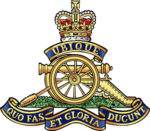 Regimental badge | |
| Active | 1883–present |
| Country | |
| Branch | |
| Type | Artillery |
| Motto(s) | Latin: Ubique, lit. 'Everywhere' and Latin: Quo fas et gloria ducunt, lit. 'Whither right and glory lead' |
| March |
|
| Commanders | |
| Captain General | Elizabeth II |
| Insignia | |
| Headdress | Dark blue beret |
| Part of a series on the |
| Military history of Canada |
|---|
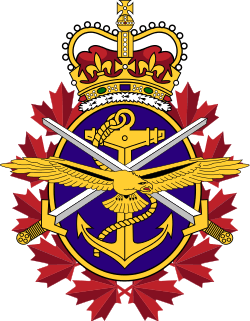 |
| Military history of... |
| Conflicts |
|
| Installations |
| Lists |
|
|
History
Many of the units and batteries of the Royal Regiment of Canadian Artillery are older than the Dominion of Canada itself. The first artillery company in Canada was formed in the province of Canada (New France) in 1750.
Volunteer Canadian artillery batteries existed before 1855 but their history is mostly unknown. Seven batteries of artillery were formed after the passage of the Militia Act of 1855 which allowed Canada to retain a paid military force of 5,000 men. One of the pre-1855 volunteer batteries formed in Saint John, New Brunswick, in 1793 was called the “Loyal Company of Artillery” and exists today as the 3rd Field Artillery Regiment, RCA.
After Confederation
On 20 October 1871, the first regular Canadian army units were created, in the form of two batteries of garrison artillery; thus, that date is considered the regiment's birthday. "A" Battery in Kingston, Ontario, and "B" Battery in Quebec City, Quebec, became gunnery schools and performed garrison duties in their respective towns. They are still active today as part of the 1st Regiment, Royal Canadian Horse Artillery.
The Royal Canadian Artillery has participated in every major conflict in Canada's history.
Riel Rebellions
In 1870, in response to the Red River Rebellion led by Louis Riel, Colonel Garnet Wolseley led a force of British regulars and Canadian Militia across Northern Ontario to quell the uprising. The force never partook in any combat. Following the establishment of Manitoba in May 1870, the militia portion of the force was garrisoned along the Red River. After 1872 this included the newly formed Manitoba Demi-Battery, which was composed of Regular gunners of A and B Battery.
In 1885, when Riel led the North-West Rebellion in the District of Saskatchewan, A and B Batteries, as well as several militia batteries, including the Winnipeg Field Battery, were dispatched to quell the uprising. Upon arriving in Saskatchewan, A Battery and Winnipeg Field fought at Fish Creek and Batoche. B Battery moved west to Swift Current where they participated in the Battle of Cut Knife, which saw the first use by Canadian soldiers of the machine gun, and the last time in Canadian history that bows and arrows were used in battle.
In 1886, the Regular Gunners of A & B Batteries returned east, transferring their guns to the North-West Mounted Police.[1]
Boer War
During the war in South Africa, Canada contributed the Brigade Division of the Canadian Field Artillery. It consisted of three batteries, named "C", "D" and "E", each of six 12-pounder field guns. Each battery consisted of three sections of two guns each, and was manned by a core of Permanent Force soldiers, with additional members from the Militia. The militia for "C" and "D" batteries came from Ontario and Winnipeg, while "E" battery had militia from Quebec, New Brunswick, and Nova Scotia.[2]
"D" and "E" Batteries arrived in Cape Town aboard the SS Laurentian in February 1900,[2] and were soon sent north to form part of a column based at Victoria West under Colonel Sir Charles Parsons. In March and April they took part in an operation in the Kenhardt district, covering 700 miles (1,100 km) in six weeks, seeing little action, but much heavy rain. On 29 May, "E" battery was part of another operation under Lieutenant-General Sir Charles Warren, when it was attacked at Faber's Put. The Boers were eventually driven off, though the battery had one man killed and eight wounded. In his subsequent despatch Warren particularly mentioned "E" Battery's Major Ogilvie and Captain Mackie. By the end of June "E" Battery had been split up into sections and was stationed along the Kimberley–Mafeking Railway.[3]
In July 1900 "D" Battery moved to Pretoria to operate in the Transvaal in a column commanded by Colonel Ian Hamilton,[3] and saw much action, with a section particularly distinguishing itself at the battle of Leliefontein,[2] when 100 men of the Royal Canadian Dragoons and 2nd Canadian Mounted Rifles, bolstered by a single Colt machine gun and the two 12-pounders of the battery, repelled an attack by 200 mounted Boers while covering the withdrawal of the main column. Three Victoria Crosses were won during the engagement.[4]
"C" Battery arrived at Cape Town aboard the SS Columbian in March 1900, but within two weeks were re-embarked to sail to Beira, from where they travelled by train, cart, and forced march to join Lieutenant-Colonel Herbert Plumer's column 70 miles (110 km) south of Otse by mid-April to take part in the relief of Mafeking. Colonel Baden-Powell, the garrison commander at Mafeking, sent a telegram to the Canadian Government stating : Mafeking relieved today, and most grateful for invaluable assistance of Canadian Artillery, which made record march from Beira to help us. From the end of May the battery operated with Plumer's column in the Zeerust district until November, seeing action regularly.[3]
The unit never operated as a whole, with the batteries, and sometimes even sections, operating independently, often for months at a time, and it was only reunited when it regrouped to return to Canada in June 1901.[2]
World War I
The Canadian Artillery and the Garrison Artillery were the designations of the Non-Permanent Active Militia as of 1 January 1914. The Canadian Artillery and the Garrison Artillery were collectively redesignated the Royal Canadian Artillery on 3 June 1935.
By November 1918, the 1st Canadian Division had expanded to the following artillery units:
- 1st Brigade, C.F.A.
- 1st Field Battery
- 3rd Field Battery
- 4th Field Battery
- 2nd Howitzer Battery
- 2nd Brigade, C.F.A.
- 5th Field Battery
- 6th Field Battery
- 7th Field Battery
- 48th Howitzer Battery
- 1st Division Ammunition Column
By November 1918, the 2nd Canadian Division had expanded to the following artillery units:
- 5th Brigade, C.F.A.
- 17th Field Battery
- 18th Field Battery
- 20th Field Battery
- 23rd Howitzer Battery
- 6th Brigade, C.F.A.
- 15th Field Battery
- 16th Field Battery
- 25th Field Battery
- 22nd Howitzer Battery
- 2nd Division Ammunition Column
By November 1918, the 3rd Canadian Division had expanded to the following artillery units:
- 9th Brigade, C.F.A.
- 31st Field Battery
- 33rd Field Battery
- 45th Field Battery
- 36th Howitzer Battery
- 10th Brigade, C.F.A.
- 38th Field Battery
- 39th Field Battery
- 40th Field Battery
- 35th Howitzer Battery
- 3rd Division Ammunition Column
By November 1918, the 4th Canadian Division had expanded to the following artillery units:
- 3rd Brigade, C.F.A.
- 10th Field Battery
- 11th Field Battery
- 12th Field Battery
- 9th Howitzer Battery
- 4th Brigade, C.F.A.
- 13th Field Battery
- 19th Field Battery
- 27th Field Battery
- 21st Howitzer Battery
- 4th Division Ammunition Column
Canadian Corps Troops - Corps Heavy Artillery
- 1st Brigade, C.G.A.
- 1st Siege Battery
- 3rd Siege Battery
- 7th Siege Battery
- 9th Siege Battery
- 2nd Brigade, C.G.A.
- 1st Heavy Battery
- 2nd Heavy Battery
- 2nd Siege Battery
- 4th Siege Battery
- 5th Siege Battery
- 6th Siege Battery
- 3rd Brigade, C.G.A.
- 8th Siege Battery
- 10th Siege Battery
- 11th Siege Battery
- 12th Siege Battery
5th Divisional Artillery
- 13th Brigade, C.F.A.
- 52nd Field Battery
- 53rd Field Battery
- 55th Field Battery
- 51st Howitzer Battery
- 14th Brigade, C.F.A.
- 60th Field Battery
- 61st Field Battery
- 66th Field Battery
- 58th Howitzer Battery
- 5th Division Ammunition Column
Army Service Corps - 5th Divisional Artillery Motor Transport Detachment
Canadian Cavalry Brigade - Artillery - Royal Canadian Horse Artillery Brigade
Army troops - Attached to the British Expeditionary Force - Artillery
- 8th Army Brigade, C.F.A.
- 24th Field Battery
- 30th Field Battery
- 32nd Field Battery
- 43rd Howitzer Battery
- 8th Army Brigade Ammunition Column
- "E" Anti-Aircraft Battery
World War II
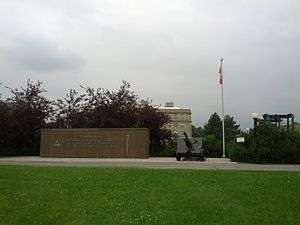
The R.C.H.A. and R.C.A. expanded tremendously during the war to contribute the following units to the European theater:
- 1st Canadian Infantry Division
- 1st Field Regiment, Royal Canadian Horse Artillery
- 2nd Field Regiment, Royal Canadian Artillery
- 3rd Field Regiment, Royal Canadian Artillery
- 1st Anti-Tank Regiment
- 2nd Light Anti-Aircraft Regiment
- 2nd Canadian Infantry Division
- 4th Field Regiment
- 5th Field Regiment
- 6th Field Regiment
- 2nd Anti-Tank Regiment
- 3rd Light Anti-Aircraft Regiment
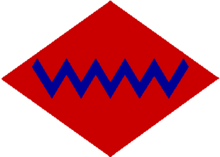
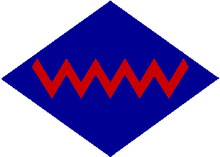
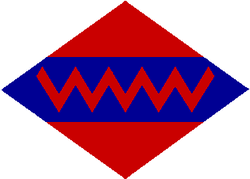
- 3rd Canadian Infantry Division
- 12th Field Regiment
- 13th Field Regiment
- 14th Field Regiment
- 3rd Anti-Tank Regiment
- 4th Light Anti-Aircraft Regiment
- 4th Canadian (Armoured) Division
- 15th Field Regiment
- 23rd Field Regiment (Self-Propelled)
- 5th Anti-Tank Regiment
- 8th Light Anti-Aircraft Regiment
- 5th Canadian (Armoured) Division
- 17th Field Regiment
- 8th Field Regiment (Self-Propelled)
- 4th Anti-Tank Regiment
- 5th Light Anti-Aircraft Regiment
- I Canadian Corps Troops
- 7th Anti-Tank Regiment R.C.A.
- 1st Survey Regiment R.C.A.
- II Canadian Corps Troops
- 6th Anti-Tank Regiment R.C.A.
- 2nd Survey Regiment R.C.A.
- 6th Light Anti-Aircraft Regiment R.C.A.
- First Canadian Army Troops
- No. 1 Army Group R.C.A.
- 11th Army Field Regiment
- 1st Medium Regiment, Royal Canadian Artillery
- 2nd Medium Regiment, Royal Canadian Artillery
- 5th Medium Regiment, Royal Canadian Artillery
- No. 2 Army Group R.C.A.
- 19th Army Field Regiment
- 3rd Medium Regiment, Royal Canadian Artillery
- 4th Medium Regiment, Royal Canadian Artillery
- 7th Medium Regiment, Royal Canadian Artillery
- No. 1 Army Group R.C.A.
Coastal defences Pacific coast
The RCA was also responsible for the defence of Canada on both the west and east coasts. In 1936 a review was done by Major Treatt of the Royal Artillery of the existing defences and potential sites for new forts. Efforts to improve the existing fortifications and build new ones were well underway by 1939.
There were approximately 10 armed forts and gun positions established along the Pacific west coast. The ones in the Strait of Juan de Fuca were integrated with the U.S. coastal defences. As the war progressed and the threat of attack diminished, the forts were gradually drawn down and demobilized. The last active coastal defence fort on the west coast, Fort Rodd Hill,[5] was deactivated in 1958.
A list of forts and gun positions on the West Coast section
Korean War
Cold War
The Regular and Reserve components of the Royal Canadian Horse Artillery, Royal Canadian Artillery and Royal Canadian Garrison Artillery were collectively redesignated the Royal Regiment of Canadian Artillery on 29 October 1956.
Afghanistan
In December 2005, 1st Regiment, Royal Canadian Horse Artillery, conducted an inaugural firing of its first 155 mm M777 towed howitzers. The first six guns delivered were supplied by the United States Marine Corps under a Foreign Military Sales (FMS) contract between the U.S. and Canada. The Canadian guns were first fired by A Battery, 1 RCHA at CFB Shilo and then were deployed to Afghanistan in support of Operation Archer, and were put into service in the Canadian theatre of operations around Kandahar in early 2006. This marked the first use by any nation of the M777 in combat operations. Regular RCHA units, reinforced by volunteers from Reserve units, continued to support operations until Canada completed its combat mission in Afghanistan in March 2014.
Since Afghanistan
In June 2017, the Royal Canadian Artillery Band, one of only two Regular bands in the Canadian Army, provided musical support for a contingent of the 2nd Battalion, Princess Patricia's Canadian Light Infantry which provided the Queen's Guard at Buckingham Palace, St James's Palace and the Tower of London, as well as Windsor Castle. In October–November 2018, the Band again deployed to England to provide musical support for a contingent from the 3rd Battalion, The Royal Canadian Regiment, which provided the Queen's Guard.
Units of The Royal Regiment of Canadian Artillery
The Royal Regiment of Canadian Artillery is composed of both regular and reserve (militia) forces. The regular force component is composed of five units, four of which are front line operation units; of these, three are field artillery regiments while the fourth is a low level air defence unit. The fifth regular unit is the Royal Canadian Artillery School. Additionally, while the three field artillery regiments are on the RCA's order of battle, they are addressed as elements of the Royal Canadian Horse Artillery.
Regulars
- 1st Regiment, Royal Canadian Horse Artillery
- "A" Battery
- "B" Battery
- "C" Battery
- "Z" Battery
- Headquarters and Services Battery
- 2nd Regiment, Royal Canadian Horse Artillery
- "D" Battery
- "E" Battery
- "F" Battery
- "Y" Battery
- Headquarters and Services Battery
- 4th Artillery Regiment (General Support),[6] Royal Canadian Artillery (formerly 4th Air Defence Regiment)
- 5e Régiment d'artillerie légère du Canada.[7]
- Batterie "X" - howitzer battery
- Batterie "Q" - howitzer battery
- Batterie "R" - surveillance and target acquisition battery
- Batterie "V" - forward observation battery
- Batterie de Commandement et Services
- The Royal Regiment of Canadian Artillery School
- "W" Battery (Formerly of the presently stood-down 4th Regiment, Royal Canadian Horse Artillery)
- 45th Depot Battery, RCA (Fire Support)
- 67th Depot Battery, RCA (The Gatekeepers)
- Headquarters Battery
Reserves
Regiments
- 1st (Halifax-Dartmouth) Field Artillery Regiment, RCA (Halifax)
- 51st Field Battery, RCA
- 87th Field Battery, RCA
- 2nd Field Artillery Regiment, RCA (Montreal)
- 7th Field Battery, RCA
- 50th Field Battery, RCA
- 66th Field Battery, RCA
- 3rd Field Artillery Regiment, RCA (Saint John, New Brunswick)
- 89th Field Battery, RCA
- 115th Field Battery, RCA (The Loyal Company)
- 5th (British Columbia) Field Artillery Regiment, RCA [8]
- 155th Field Battery, RCA (Victoria, British Columbia)
- 156th Field Battery, RCA (Nanaimo, British Columbia)
- The Band of the 5th (BC) Field Regiment, RCA (Victoria, British Columbia)
- 6th Field Artillery Regiment, RCA (Lévis, Quebec)
- 57th Field Battery, RCA
- 59th Field Battery, RCA
- 58th Field Battery, RCA
- 7th Toronto Regiment, RCA
- 9th Field Battery, RCA
- 15th Field Battery, RCA
- 130th Field Battery, RCA
- The Band of the 7th Toronto Regiment, RCA
- 10th Field Artillery Regiment, RCA
- 18th Field Battery, RCA (Regina, Saskatchewan)
- 64th Field Battery, RCA (Yorkton, Saskatchewan)
- 11th Field Artillery Regiment, RCA (Guelph, Ontario)
- 11th Field Battery (Hamilton-Wentworth), RCA
- 16th Field Battery, RCA
- 29th Field Battery, RCA
- 15th Field Artillery Regiment, RCA (Vancouver, British Columbia)
- 31st Field Battery, RCA
- 68th Field Battery, RCA
- The Band of the 15th Field Regiment, RCA
- 20th Field Artillery Regiment, RCA
- 61st Field Battery, RCA (Edmonton, Alberta)
- 78th Field Battery, RCA (Red Deer, Alberta)
- 26th Field Artillery Regiment, RCA
- 13th Field Battery, RCA (Portage la Prairie, Manitoba)
- 71st Field Battery, RCA (Brandon, Manitoba)
- 30th Field Artillery Regiment, RCA (Ottawa)
- 1st Field Battery, RCA
- 2nd Field Battery, RCA
- 42nd Field Artillery Regiment (Lanark and Renfrew Scottish), RCA (Pembroke, Ontario)[8]
- 35th Field Battery, RCA
- 49th Field Artillery Regiment, RCA (Sault Ste. Marie, Ontario)
- 30th Field Battery, RCA
- 148th Field Battery, RCA
- 56th Field Artillery Regiment, RCA (Brantford, Ontario)
- 10th Field Battery, RCA
- 54th Field Battery, RCA
- 69th Field battery, RCA
- 62nd Field Artillery Regiment, RCA (Shawinigan, Quebec)
- 81st Field Battery, RCA
- 185th Field Battery, RCA
Independent batteries
- 20th Independent Field Battery, RCA (Lethbridge, AB)
- 84th Independent Field Battery, RCA (Yarmouth, Nova Scotia)
- 116th Independent Field Battery, RCA (Kenora, Ontario)
Since spring 2005, 10th Field Regiment, 26th Field Regiment and 116th Independent Field Battery have been grouped together as 38 Canadian Brigade Group's (38 CBG) Artillery Tactical Group (ATG).
Bands
Current:
- The Royal Canadian Artillery Band, Edmonton, AB (Regular Force)
- The Band of the 5th (BC) Field Regiment, RCA, Victoria, BC (Reserve Force)
- The Band of the 7th Toronto Regiment, RCA, Toronto, ON (Reserve Force)
- The Band of the 15th Field Regiment, RCA, Vancouver, BC (Reserve Force)
Former:
- RCA 11th Field Regiment Trumpet Band
- RCA 44th Field Regiment Trumpet Band
- RCA 30th Field Regiment Trumpet Band
- RCA 8th Field Regiment Trumpet Band
- RCA 56th Field Regiment Trumpet Band
- RCA 7th Field Regiment Trumpet Band
Order of precedence
RCHA on parade with guns:
| Preceded by Naval Operations Branch |
The Royal Canadian Horse Artillery (See note below) |
Succeeded by Army elements of Royal Military College of Canada |
RCHA on dismounted parades:
| Preceded by Army elements of Royal Military College of Canada |
The Royal Canadian Horse Artillery (See note below) |
Succeeded by Royal Canadian Armoured Corps |
RCA units:
| Preceded by Royal Canadian Armoured Corps |
The Royal Canadian Artillery | Succeeded by Corps of Royal Canadian Engineers |
Note: Despite not being the senior component of the Canadian Army, the honour of "the right of the line" (precedence over other units), on an army parade, is held by the units of the Royal Canadian Horse Artillery when on parade with their guns. On dismounted parades, RCHA units take precedence over all other land force units except formed bodies of Officer Cadets of the Royal Military College of Canada representing their college. RCA units parade to the left of units of the Royal Canadian Armoured Corps. The Royal Canadian Artillery does not carry colours. Its guns are its colours and are saluted on parade.
Affiliations

.svg.png)

Royal Canadian Artillery Museum
| Location | CFB Shilo, P.O. Box 5000, Stn Main, Shilo, Manitoba, Canada |
|---|---|
| Type | Artillery Museum |
As the principal artillery museum in Canada, the Royal Canadian Artillery Museum presents, acquires, preserves, researches and interprets the contributions of the Royal Regiment of Canadian Artillery and the Canadian military to the heritage of Canada.[9] The museum is affiliated with: CMA, CHIN, OMMC and Virtual Museum of Canada.
Memorials
A memorial wall and an artillery field gun, were erected on 21 September 1959 by the Royal Regiment of Canadian Artillery, which is dedicated to the memory of the members of the regiment killed in the service of Canada. It was relocated from its original location at Major's Hill Park to Green Island Park in Ottawa, Ontario and rededicated on 24 May 1998.[10]
Recognition
The freedom of the city was accepted by the 5th (British Columbia) Field Battery, Royal Regiment of Canadian Artillery in Victoria, British Columbia on 4 November 1979.[11]
Armoury
| Site | Date(s) | Designated | Location | Description | Image |
|---|---|---|---|---|---|
| Colonel D. V. Currie VC Armoury, 1215 Main Street North. | 1913-14 | 1998 Register of the Government of Canada Heritage Buildings | Moose Jaw, Saskatchewan |
|
Popular culture
The Royal Canadian Artillery is playable force featured heavily in the video game Company of Heroes: Opposing Fronts. They are also a playable force in the Wargame franchise in "Wargame: Airland Battle" and "Wargame: Red Dragon".
See also
- Military history of Canada
- History of the Canadian Army
- Canadian Forces
- List of armouries in Canada
- Organization of Military Museums of Canada
- Canadian Forces Land Force Command
- List of Canadian organizations with royal patronage
- Monarchy of Canada
References
- Notes
- RCA Concise History
- "South African War - Brigade Division, Royal Canadian Field Artillery". Canadian War Museum. 2014. Retrieved 2 December 2014.
- Biggins, David (2014). "Royal Canadian Artillery". The Anglo-Boer War. Retrieved 2 December 2014.
- Milner, John M. (2014). "The Boer War – Canada's First "Foreign War"". Victoria Park. Retrieved 2 December 2014.
- "Fort Rodd Hill". Fort Rodd Hill National Historic Site Victoria. 2014. Retrieved 2 December 2014.
- "4th Air Defence Regiment, RCA". Canadian Armed Forces. 2014. Retrieved 2 December 2014.
- Canadian Gunner/L'Arilleur Canadian 2010, p. 27
- A-DH-267-003 Insignia and Lineages of the Canadian Forces, Volume 3: Combat Arms Regiments. Department of National Defence. 15 January 2010.
- A-AD-266-000/AG-001 Canadian Forces Museums – Operations and Administration. 3 April 2002.
- "Royal Regiment of Canadian Artillery Memorial". DND Directorate of History and Heritage. 2014. Archived from the original on 17 May 2014. Retrieved 2 December 2014.
- "5th (British Columbia) Field Artillery Regiment". Canadian Army. 2014. Retrieved 2 December 2014.
- Bibliography
- Barnes, Leslie (1979). Canada's Guns; an Illustrated History of Artillery. Ottawa: Canadian War Museum.
- Camp, A. D. (1966). 7th Toronto Regiment, Royal Regiment of Canadian Artillery, 1866-1966. Toronto.
- Fromow, D. L. (March 2004). Canada's Flying Gunners: A History of the Air Observation Post of the Royal Regiment of Canadian Artillery.
- Jackson, Harold McGill (1952). The Royal Regiment of Artillery, Ottawa, 1855-1952; a history. Ottawa.
- Macdonald, Reginald James (1899). The history of the dress of the Royal Regiment of Artillery, 1625-1897. London: H. Sotheran.
- Mitchell, George Duncan; Reid, B. A. & Simcock, W. (1986). RCHA - Right of the Line: An Anecdotal History of the Royal Canadian Horse Artillery from 1871. Ottawa: RCHA History Committee.
- Nicholson, G. W. L. (1967). The Gunners of Canada: The History of the Royal Regiment of Canadian Artillery Volume I: 1534-1919.
- Nicholson, G. W. L. (1972). The Gunners of Canada: The History of the Royal Regiment of Canadian Artillery Volume II: 1919-1967.
- Nicholson, G. W. L. (1967–72). The Gunners of Canada; the History of the Royal Regiment of Canadian Artillery. Toronto: McClelland & Stewart.
- "11th Field Artillery Regiment, Royal Regiment of Canadian Artillery : Canada's oldest artillery regiment." (Guelph, Ontario : The Regiment), 1966.
- "Presence of the Royal Artillery regiment at Quebec from 1759 to 1871" (Canada. Dept. of Indian Affairs and Northern Development. National Historic Parks and Sites Br. National government publication 1978.)
External links
| Wikimedia Commons has media related to Royal Regiment of Canadian Artillery. |